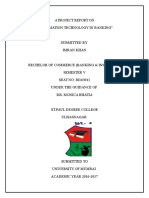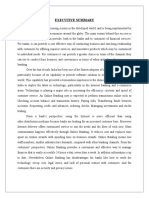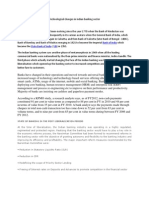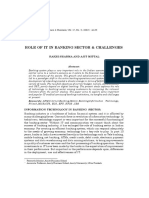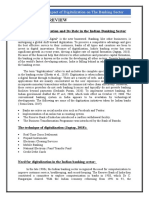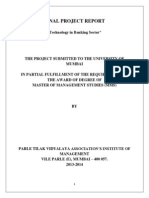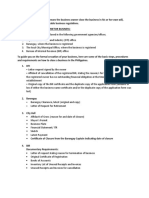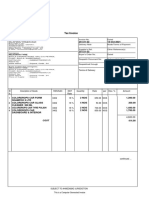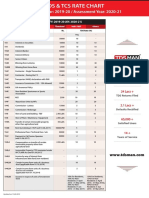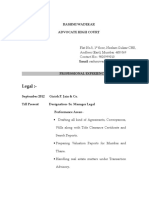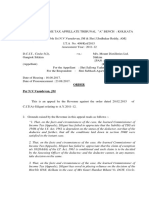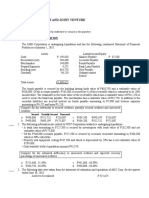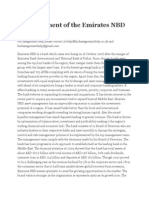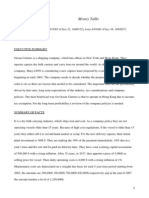UNIT – I
(BASIC NOTES – MUST BE READ ALONG WITH CLASS OBSERVATION NOTES)
Introduction.
The concept of Bank Automation/mechanization/Computerisation (Presently) in India
practically started after 1980-81 and more precisely gained pace in the year 1983-84, after
setting up a committee in the year 1983 under the chairmanship of the then Deputy Governor
of RBI, Dr C. Rangarajan.
Need for Computerisation.
The five major objectives of computerization in banking are to improve:
(a) Customer Service.
(b) Maintenance.
(c) Decision-making.
(d) Productivity and
(e) Profitability.
Initiatives of RBI, CVC, GOI towards Mechanization / Computerization.
For General Knowledge – related to Automation and computerization
(Past Scenario- Article 1 for practical knowledge building).
A Bird’s Eye View. How computerization was pushed in Indian Banking?
Page 1 of 11
Compiled Base Notes – For Students.
Note: Student must refer the examples and class observation notes for class tests/final examination.
Recommended Book: Indian Institute of Banking and Finance, Banking Technology- Macmillan, Mumbai
�Well, obviously there is a lot of excitement these days around technology in Indian banking
space. However, how did this process actually start? – (Refer to the below article).
A nice article which looks at this history of introducing computers in banking. It was a process
that started around 1982, contrarian to most who would think it started post-1991 (LPG Period).
Actually, much of changes in Indian economy started around the 1980s (some say 1970’s
around Emergency) and 1991 is just that time when all these things came together and became
more reinforced due to LPG move by the GOI.
Article:
A few months after Manmohan Singh took over as RBI Governor in September 1982, in a
reshuffle of portfolios, one of his deputy governors, C Rangarajan, who had joined a little earlier
during the previous governor IG Patel’s tenure, was assigned the responsibility of some of the
major operational departments within the central bank, including monetary policy and
exchange rate management. Rangarajan, who had taught at IIM Ahmedabad for long, had
virtually little to do during the Patel days, with no core functional responsibilities in the first half
of 1982, but that changed when Singh took over.
One of the primary issues Singh took up was the computerization of banking operations. He
knew that there would be resistance to the change from unions and staff and so, told them that
given the pace of global growth and technological advancement, mechanization was inevitable.
Those were the days of enormous delays in cheque clearances, with money taking weeks to get
credited to the accounts of customers, defeating the objective of moving away from currency
to paper-based transactions. Worryingly, there were lots of issues relating to reconciliation or
tallying of transactions at the end of the day. There were instances of funds being set aside in
separate accounts to handle these discrepancies. Singh told the bankers and the unions that the
process of computerization was not just about boosting productivity in the industry, as was
evident in many other parts of the world, but also involved public interest in providing better
services.
There was a sequencing here as well:
Prior to that, a few computers were installed in the bank with the staff being told that it was for
data collection and analysis, not for transactions. By 1982, a decision had been taken to
computerize cheque clearing operations. Slowly, it was extended to the central bank’s clearing
Page 2 of 11
Compiled Base Notes – For Students.
Note: Student must refer the examples and class observation notes for class tests/final examination.
Recommended Book: Indian Institute of Banking and Finance, Banking Technology- Macmillan, Mumbai
�houses and for its own transactions. Singh then appointed a committee headed by Rangarajan
to consider mechanization in the banking industry. The trade unions, especially those in West
Bengal, were fiercely opposed to this change because they feared mechanisation would lead to
job losses. Singh met with then West Bengal chief minister Jyoti Basu without much success.
Deputy Governor Rangarajan then went to meet Basu, who told Rangarajan to first convince his
ministers. Rangarajan is known to have responded politely, saying he thought that was the chief
minister’s job.
That was the time Basu had just returned from a trip to Germany and may have found merit in
Rangarajan’s arguments but persuading workers wasn’t an easy task. The resistance of unions
and workers in Calcutta, as the city was known then, was so high that handling of payments
and settlements, which involved computerization or mechanization, had to be done out of
another office and not the main regional office of the RBI in that city. Commercial banks too
were loath to adopt these changes given the internal resistance.
But slowly, as resistance thinned, a National Clearing Cell was created in 1983. New technology
for sorting cheques mechanically was introduced to ensure clearing of outstation cheques at
the national level. As the collection of cheques became faster, over the next few years,
computerization of clearing operations was taken up in key metros and other cities. Slowly,
government payment receipts and transactions were also covered and soon, by the end of the ’80s,
the central bank was able to clear high-value transactions.
Around that time, another government undertaking, the Indian Railways, had switched to
computerization in ticketing, with huge benefits to its commuters.
And then later in 1991 – (LPG Era Beginning and developments)
With the opening up of the economy in 1991-92, the process of computerization gained pace. What
further propelled the change was the securities scam of that period which exposed the chinks
in the system than on clearing, payments, and settlement. Based on a report of a Joint
Parliamentary Committee, the central bank started looking at evolving a modern
communication network for the banking industry, reflected later in electronic funds transfer
and up-gradation of technological systems.
Page 3 of 11
Compiled Base Notes – For Students.
Note: Student must refer the examples and class observation notes for class tests/final examination.
Recommended Book: Indian Institute of Banking and Finance, Banking Technology- Macmillan, Mumbai
�The other major driver of change then was private banks. By 1994-95 and in the years that
followed, the newly licensed private banks in India leveraged technology in a big way,
differentiating themselves from state-run banks. That forced banks who had resisted such
changes a few years ago to follow suit, transforming the banking landscape in the next decade.
Well over three decades later now, India has moved to new forms of banking with licensing of
payment banks, electronic fund transfer and the seamless transfer of money.
Impact of computerization on customer service.
Information technology or computerization in banking sector refers to the use of sophisticated
information and communication technologies together with computer science to enable banks
to offer better services to its customers in a secure, reliable and affordable manner and sustain
competitive advantage over other banks. The significance of technology is greatly felt in the
financial sector in view of the competitive advantage for banks resulting in inefficient customer
service.
In the development of Indian Economy, the banking sector plays a very important and crucial
role. With the use of technology, there had been an increase in penetration, productivity, and
efficiency. It has not only increased the cost-effectiveness but also has helped in making small
value transactions viable. Electronic delivery channels, ATMs, variety of cards, web-based
banking, and mobile banking are the names of a few outcomes of the process of automation.
Transformation of Indian Banking: -
Indian banking has undergone a total transformation over the last decade. Moving seamlessly
from a manual, scale-constrained environment to a technological leading position, it has been
a miracle. Such a transformation takes place in such a short span of time with such a low cost.
The entry of technology in the Indian banking industry can be traced back during the 1990s,
the banking sector witnessed various liberalization measure. One of the major objectives of
Indian banking sector reforms was to encourage operational self-sufficiency, flexibility, and
competition in the system and to increase the banking standards in India to the international
best practices. With the ease of licensing norms, new private and foreign banks emerged-
equipped with the latest technology. Deregulation has opened up new opportunities to banks
to increase revenues by diversifying into investment banking, insurance, credit cards, mortgage
financing, depository services, etc. The role of banking is redefined from a mere intermediary
Page 4 of 11
Compiled Base Notes – For Students.
Note: Student must refer the examples and class observation notes for class tests/final examination.
Recommended Book: Indian Institute of Banking and Finance, Banking Technology- Macmillan, Mumbai
�to service provider of various financial services under one roof acting as a financial
supermarket.
Important events in the evolution of Information Technology: -
Introduction of MICR based cheque processing
The arrival of card-based payments (POS)
Introduction of Electronic Clearing Services
Introduction of RTGS/NEFT
Introduction of Cheque Truncation System (CTS) or Image-based Clearing System
(ICS)
Introduction of Core Banking Solutions (CBS)
Introduction of Automated Teller Machine (ATMs)
Introduction of Phone and Tele Banking
Introduction of Internet and Mobile Banking.
MICR MODEL CHEQUE – WITH BASIC DESCRIPTIONS.
Impact of computerization on customer service.
Electronic Payment and Settlement System – The most common media of receipts and
payment through banks are negotiable instruments like cheques. These instruments could be
used in place of cash. The interbank cheques could be realized through clearinghouse systems.
Initially, there was a manual system of clearing but the growing volume of banking transaction
emerged into the necessity of automating the clearing process.
Use of MICR Technology – MICR overcomes the limitation of clearing the cheques within
banking hours and thus enables the customer to get the credit quickly. These are machine-
Page 5 of 11
Compiled Base Notes – For Students.
Note: Student must refer the examples and class observation notes for class tests/final examination.
Recommended Book: Indian Institute of Banking and Finance, Banking Technology- Macmillan, Mumbai
�readable codes added at the bottom of every cheque leaf which helped in the bank and branch-
wise sorting of cheques for smooth delivery to the respective banks on whom they are drawn.
This no doubt helped in speeding up the clearing process, but physical delivery of cheques
continued even under this partial automation.
CTS (Cheque Truncation System) – Truncation means stopping the flow of the physical
cheques issued by a drawer to the drawee branch. The physical instrument the at some point
on the route to the drawee branch and an electronic image of the cheque is sent to the drawee
branch along with the relevant information like the MICR fields, date of presentation,
presenting banks, etc. This would eliminate the need to move the physical instruments across
branches, except in exceptional circumstances, resulting in an effective reduction in the time
required for payment of cheques, the associated cost of transit and delays in processing, etc.,
thus speeding up the process of collection or realization of cheques.
Electronic Clearing Services (ECS) – The ECS was the first version of “Electronic
Payments” in India. It is a mode of electronic funds transfer from one bank account to another
bank account using the mechanism of the clearinghouse. It is very useful in case of bulk
transfers from one account to many accounts or vice-versa. The beneficiary has to maintain an
account with one of the banks at ECS Centre.
There are two types of ECS (Electronic Clearing Service)
ECS – Credit: ECS Credit clearing operates on the principle of ‘single debit multiple credits’
and is used for transactions like payment of salary, dividend, pension, interest, etc.
ECS – Debit: ECS Debit clearing service operates on the principle of ‘single credit multiple
debits’ and is used by utility service providers for collection of electricity bills, telephone bills,
and other charges and also by banks for collections of principal and interest repayments.
Electronic Fund Transfer (EFT) – EFT was a nationwide retail electronic fund transfer
mechanism between the networked branches of banks. NEFT provided for integration with the
Structured Financial Messaging Solution (SFMS) of the Indian Financial Network (INFINET).
The NEFT uses SFMS for EFT message creation and transmission from the branch to the
bank’s gateway and to the NEFT Centre, thereby considerably enhancing the security in the
transfer of funds.
Page 6 of 11
Compiled Base Notes – For Students.
Note: Student must refer the examples and class observation notes for class tests/final examination.
Recommended Book: Indian Institute of Banking and Finance, Banking Technology- Macmillan, Mumbai
�Real-Time Gross Settlement (RTGS) – RTGS system is a fund transfer mechanism where
the transfer of money takes place from one bank to another on a ‘real-time’ and on ‘gross basis’.
This is the fastest possible money transfer system through the banking channel. Settlement in
‘real-time’ means payment transaction is not subjected to any waiting period. The transactions
are settled as soon as they are processed. “Gross settlement” means the transaction is settled on
one to one basis without bunching with any other transaction.
Core Banking Solutions (CBS) – Computerization of bank branches had started with the
installation of simple computers to automate the functioning of branches, especially at high
traffic branches. Core Banking Solutions is the networking of the branches of a bank, so as to
enable the customers to operate their accounts from any bank branch, regardless of which
branch he opened the account with. The networking of branches under CBS enables centralized
data management and aids in the implementation of internet and mobile banking. Besides, CBS
helps in bringing the complete operations of banks under a single technological platform.
Automated Teller Machine (ATM) – ATMs are perhaps the most revolutionary aspect of
virtual banking. The facility to use ATM is provided through plastic cards with a magnetic strip
containing information about the customer as well as the bank. In today’s world ATM are the
most useful tool to ensure the concept of “Any Time Banking” and “Anywhere Banking”.
Phone Banking – Customers can now dial up the bank's designed telephone number and he by
dialling his ID number will be able to get connectivity to bank’s designated computer. By using
Automatic voice recorder (AVR) for simple queries and transactions and manned phone
terminals for complicated queries and transactions, the customer can actually do entire non-
cash relating banking on telephone: Anywhere, Anytime.
Tele Banking – It is another innovation, which provided the facility of 24-hour banking to the
customer. Tele-banking is based on the voice processing facility available on bank computers.
The caller usually a customer calls the bank anytime and can enquire balance in his account or
any other transaction history.
Page 7 of 11
Compiled Base Notes – For Students.
Note: Student must refer the examples and class observation notes for class tests/final examination.
Recommended Book: Indian Institute of Banking and Finance, Banking Technology- Macmillan, Mumbai
�Internet Banking – Internet banking enables a customer to do banking transactions through
the bank’s website on the internet. It is a system of accessing accounts and general information
on bank products and services through a computer while sitting in its office or home. This is
also called virtual banking.
Mobile Banking – Mobile banking facility is an extension of internet banking. Mobile banking
is a service provided by a bank or other financial institution that allows its customers to conduct
financial transactions remotely using a mobile device. Unlike the related internet banking it
uses the software, usually called an App, provided by the financial institution for the purpose.
Mobile banking is usually available on a 24-hour basis. Some financial institutions have
restrictions on which accounts may be accessed through mobile banking, as well as a limit on
the amount that can be transacted. Transactions through mobile banking may include obtaining
account balances and lists of latest transactions, electronic bill payments, and fund transfers
between a customer to another account.
ALPM –Advance Ledger Posting Machine.
Advanced Ledger Posting Machine is the stand-alone computers with full features on SB, CA,
OD/CC, advances, term deposits, Outward Clearing, demand drafts, and back-office activities.
Major Features.
a. Automation execution of standing instructions, interest application, product
accumulation for holidays, during start day procedure.
b. Opening of account with diverse constitutions and modes of operation.
c. Closure of accounts allowed only when the balance is in credit and sufficient to cover
interest and service charges.
d. Closure not permitted for blocked or frozen accounts.
e. Automatic incorporation of accounts during half-year & year-end.
Stand-alone PC
Purpose of - Stand-alone Computer System.
The stand-alone computer system is used by only one person at a time.
Stand-alone systems are best suited for the decision-making process, which involves
processing and analysis of data.
Page 8 of 11
Compiled Base Notes – For Students.
Note: Student must refer the examples and class observation notes for class tests/final examination.
Recommended Book: Indian Institute of Banking and Finance, Banking Technology- Macmillan, Mumbai
� Stand-alone systems are also capable of handling multimedia, high-quality graphics,
fax messages simultaneously.
Networking - LAN & WAN
Local Area Network (LAN): Local Area Network (LAN) is a computer network, which is
limited to a small office, single building, multiple buildings inside a campus, etc. Typically, a
Local Area Network (LAN) is a private network owned and maintained by a single
organization.
The below image shows a small Local Area Network (LAN) connected together using a
Network Switch.
Wide Area Network (WAN): A Wide Area Network (WAN) spans over multiple geographic
locations, which is composed of multiple LANs. It is nearly impossible for a small to the
medium organization (except Network Service Providers) to pull network cables between their
two offices in two different countries located 1000s of kilometres away.
Network Service Providers (also called as ISPs) provide the connectivity solutions for Wide
Area Networks (WAN).
Below image shows two Local Area Networks (LANs), located at two different geographical
locations connected via the Internet to create a Wide Area Network (WAN).
Page 9 of 11
Compiled Base Notes – For Students.
Note: Student must refer the examples and class observation notes for class tests/final examination.
Recommended Book: Indian Institute of Banking and Finance, Banking Technology- Macmillan, Mumbai
�LAN 1, in Chennai, India and LAN 2 is located in Manila, Philippines. The aerial distance
between Chennai and Manila is about 4,400 Kilometres. It is almost impossible for a small to
medium business to draw cables between Chennai and Manila. So they normally avail the
services of an Internet Service Provider for connectivity between these two offices.
Differences between Local Area Networks (LANs) and Wide Area Network (WAN)
• A Local Area Network (LAN) is a private computer network that connects computers in small
physical areas. Example: A small office, A Single building, Multiple buildings inside a campus
etc. Wide Area Networks (WAN) is a type of computer network to connect offices which are
located in different geographical locations. Wide Area Network (WAN) depends mainly on
Internet Service Providers (ISPs) for connection solutions.
• Local Area Network (LAN) has higher bandwidth rates. Current Local Area Networks
(LANs) runs on bandwidths of 100 Mbps, 1 Gbps or 10 Gbps. Wide Area Networks (WAN)
has lower bandwidth rates compared with Local Area Network (LAN). Current Wide Area
Networks runs on bandwidths of 4 Mbps, 8 Mbps, 20 Mbps, 50 Mbps or 100 Mbps.
• Local Area Network (LAN) bandwidth rates are almost constant. Local Area Network (LAN)
bandwidth rates are dependent on characteristics of the LAN technology in use (Normally Fast
Ethernet or Gigabit Ethernet). Since most of Wide Area Networks (WAN) connectivity
Page 10 of 11
Compiled Base Notes – For Students.
Note: Student must refer the examples and class observation notes for class tests/final examination.
Recommended Book: Indian Institute of Banking and Finance, Banking Technology- Macmillan, Mumbai
�solutions are dependent on Internet Service Providers (ISPs), budget-related constraints affect
the quality of WAN.
• Most of the current Local Area Networks (LANs) use Ethernet as the LAN Standard (Fast
Ethernet 100 Mbps, or Gigabit Ethernet 1/10 Gbps). WAN uses technologies like VPN (Virtual
Private Network) over the Internet, MPLS, Frame Relay, or Leased Lines as WAN connectivity
solutions.
• Since Local Area Networks (LANs) are private networks, managed by dedicated local
network administrators, Local Area Networks (LANs) are more reliable and secure than Wide
Area Networks (WANs). Since Wide Area Networks (WANs) involve 3rd party service
providers, WAN networks are less reliable and secure.
• Initial set-up costs for Local Area Networks (LANs) are low as the devices required to set up
the networks are cheap. Initial set-up costs for Wide Area Networks (WANs) are high, because
of the devices (Routers, Firewalls etc), cables and manpower required.
• Local Area Networks (LANs) running costs are less Wide Area Networks (WANs) running
costs are high. Wide Area Networks (WANs) normally have recurring monthly cost as Service
Provider access fees.
• Wide Area Networks (WANs) are more congested than Local Area Networks (LANs).
==================
Page 11 of 11
Compiled Base Notes – For Students.
Note: Student must refer the examples and class observation notes for class tests/final examination.
Recommended Book: Indian Institute of Banking and Finance, Banking Technology- Macmillan, Mumbai






